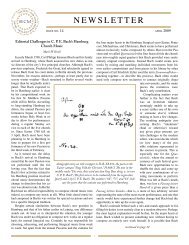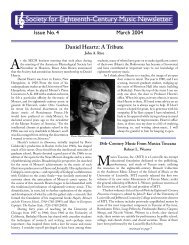NEWSLET T ER - Society for 18th-Century Music
NEWSLET T ER - Society for 18th-Century Music
NEWSLET T ER - Society for 18th-Century Music
Create successful ePaper yourself
Turn your PDF publications into a flip-book with our unique Google optimized e-Paper software.
The archival studies are uni<strong>for</strong>mly excellent, with readable, engaging<br />
prose that makes clear the data’s significance and historiographical<br />
implications. Marco Brusa’s brief study of Il Ciro in Armenia<br />
settles a niggling question of attribution by documenting the<br />
existence of two operas on the same text, concluding with observations<br />
about the difficulties of attribution and the problems caused<br />
by unexamined assumptions. Maria Grazia Sità’s “I Filarmonici in<br />
trasferta: Le uscite dei sinfonisti milanesi nel 1760 e nel 1765” details<br />
musical events occasioned by the elaborate processional journeys<br />
that preceded royal weddings. Making use of correspondence,<br />
pay registers, and other archival material (reproduced in modern<br />
transcriptions and facsimiles), Sità provides not only a fascinating<br />
glimpse of the extravagant preparations required to entertain traveling<br />
royalty but also a clear picture of Sammartini’s contribution<br />
to the events. Marina Toffetti documents Sammartini’s role as a<br />
member of various examination committees charged with selecting<br />
musicians <strong>for</strong> positions at the Duomo in Milan. Anna Cattoretti’s<br />
chronologically organized documentary biography presents the<br />
texts pertaining to Sammartini’s life and his reception by contemporaries<br />
and later commentators. Though some of the names are<br />
familiar (Charles Burney, Giuseppi Carpani), others (Giovenale<br />
Sacchi) are not, and the collection of entries from eighteenth- and<br />
nineteenth-century biographical dictionaries is especially useful<br />
and illuminating.<br />
The analytical essays about Sammartini include contributions by<br />
Bathia Churgin, Cosetta Farino (nocturnes with flute), Ada Beate<br />
Gehann, Adena Portowitz, Filippo Emanuele Ravizza (keyboard<br />
works), Tova Shany, Marina Vaccarini Gallarani, and Charles R.<br />
Verble (sacred music). Jehoash Hirshberg and Simon McVeigh,<br />
Sarah Mandel-Yehuda (Antonio Brioschi), Umberto Scarpetti<br />
(Giovanni Andrea Fioroni), and Eugene K. Wolf contribute analytical<br />
essays considering the music of Sammartini’s contemporaries.<br />
Several of the essays include thematic catalogues (Farina, Gehann,<br />
Hirshberg and McVeigh, and Ravizza). As is often the case with<br />
such collections, the quality is uneven. Some authors adopt an unnecessarily<br />
cheerleading tone and either do no more than provide<br />
a surface description of their relatively unknown pieces or—when<br />
they do venture into more interpretive territory—betray a certain<br />
historical naiveté. Though these problems do not beset Gehann’s<br />
thorough assessment of the <strong>for</strong>mal structure of Sammartini’s late<br />
concertos, it suffers somewhat from the density of her prose and<br />
the paucity of musical examples (only eight in 60 pages). Both Portowitz<br />
and Gallarini present cogent analyses—Portowitz addressing<br />
the relationship of structure and expression in Sammartini’s<br />
middle and late symphonies and Gallarini positing a typology of<br />
arias <strong>for</strong> Sammartini’s 1751 Lenten cantatas.<br />
The best of the analytical essays highlight in<strong>for</strong>mation and put<br />
<strong>for</strong>th interpretations that challenge the traditional historical narrative.<br />
Churgin, <strong>for</strong> example, marshals plentiful tables and musical<br />
examples (thirteen in 35 pages) as she documents stylistic elements<br />
typically associated with the Sturm und Drang in six minor-mode<br />
Sammartini works (four symphonies and two overtures) dating<br />
from 1744–51. Not only do her findings support the concept of<br />
the Sturm und Drang as a musical topic throughout the eighteenth<br />
century (an idea proposed by Leonard Ratner and Max Rudolf ),<br />
but they call into question the often-made assumptions about<br />
Germanic depth and Italian superficiality. Three essays offer new<br />
viewpoints on the traditional distinction between the “Baroque”<br />
and the “Early Classic” styles. Shany’s examination of the six cello<br />
sonatas ascribed to Sammartini, published in Paris in 1742, identi-<br />
6<br />
fies clear “Classic” features (tonal polarity, melodic structure, etc.)<br />
that were at odds with the sonatas’ “Baroque” sound and thus succeeded<br />
in “destroying the older style from within” (p. 359). In his<br />
discussion of Andrea Zani’s 1729 Sinfonie da Camera, op. 2, Wolf<br />
argues that their melodic repetition, contrasting tonal plateaus,<br />
and rondo finales point to trends more evident later in the century.<br />
Hirshberg and McVeigh’s excellent examination of concertos written<br />
by Milanese virtuoso instrumentalists explores the “relationship<br />
between individual, group, and universal styles” (p. 234). Their<br />
analysis documents a wide range of harmonic, textural, and <strong>for</strong>mal<br />
procedures that breaks down the distinction between Baroque and<br />
Classic and should also cause us to rethink stereotypes of German<br />
complexity and Italian simplicity. The best of the essays in<br />
this volume thus provide the best of both scholarly worlds: analytical<br />
and documentary rigor coupled with interpretative insight and<br />
thoughtful criticism.<br />
Daniel Heartz, From Garrick to Gluck: Essays on Opera in the Age<br />
of the Enlightenment. Edited by John A. Rice (Hillsdale, NY: Pendragon<br />
Press, 2004).<br />
Isabelle Emerson<br />
In his preface to this collection, John Rice declares two goals:<br />
to make available in an English collection a number of essays by<br />
Daniel Heartz that were originally published either in a <strong>for</strong>eign<br />
language journal or in a journal outside the usual purview of musicologists,<br />
and to demonstrate the breadth of Heartz’s scholarship—scholarship<br />
that draws on the disciplines of literature, dance,<br />
and the visual arts as well as music, and that speaks compellingly<br />
to both musicologist and non-musicologist readers. The collection<br />
achieves these goals with admirable success.<br />
The essays are presented in five groups—Opera Buffa, Opera Seria,<br />
Opéra-comique, The Querelle des Bouffons, and Re<strong>for</strong>m Opera. A<br />
lecture given by Heartz at the 1977 meeting in Berkeley of the<br />
International <strong>Music</strong>ological <strong>Society</strong> presented here as Overture:<br />
Les Lumières establishes the underlying theme of the collection—<br />
opera as influenced by and as expression of the Enlightenment.<br />
Within each group essays are arranged in general chronological<br />
order according to subject; ranging over western Europe from<br />
Italy to England, the eighteen essays provide vital illumination of<br />
theatrical life throughout the eighteenth century. The grouping of<br />
essays also reveals Heartz’s continuing preoccupation with all of<br />
these topics. Thus the earliest essay, “From Garrick to Gluck: The<br />
Re<strong>for</strong>m of Theater and Opera in the Mid-Eighteenth <strong>Century</strong>,”<br />
appeared in 1967–1968; the other essays from this group, Re<strong>for</strong>m<br />
Opera, appeared in 1969, 1972–1973, and 1982. Of the three essays<br />
found under Querelle des Bouffons, the first, “Grimm’s Le petit<br />
prophète de Boehmischbroda,” was written in 2001 and is published<br />
here <strong>for</strong> the first time; the other two appeared in 1997 and 1978.<br />
“Diderot and the Lyric Theatre” appears in English <strong>for</strong> the first<br />
time, translated by the author <strong>for</strong> this collection.<br />
A significant part of the pleasure to be derived from these essays<br />
comes from Heartz’s talent <strong>for</strong> writing about music; in addition<br />
to consummate musicianship he has that rare ability to create in<br />
words the effect of the music. Heartz brings to his work an unusual<br />
sensitivity <strong>for</strong> the word and the visual image coupled with vast<br />
knowledge of these materials. This is richly displayed in his discussions<br />
of texts and settings and in his frequent drawing upon visual<br />
materials <strong>for</strong> in<strong>for</strong>mation about opera stagings and personae. It is





